
Enlarged view
[Note: This module contains many links to other sites with relevant information. To return to this module after opening one of the links, simply close the window to the outside site by clicking on the "X" in the upper right corner of your browser.]
Since 1972 the Clean Water Act (CWA) has had considerable success in controlling water pollution from point sources such as municipal wastewater treatment plants and industrial discharges. Today pollutants generated by nonpoint sources are the largest cause of impairments to State Water Quality Standards and the “fishable/swimmable” goals.
This map shows watersheds at the 8-digit Hydrologic Unit Code (HUC) and the percentage of waterbodies that do not meet water quality standards. Only around 10 percent of these impairments can be resolved by addressing point sources alone.
Activities such as excavating and clearing associated with urban development and new construction are major sources of siltation and sediment. Once urban settlements are established, additional problems for nearby waterbodies are caused by increased runoff that transports pollutants such as automobile fluids, lawn care products, pet waste and trash. The process of urban development also affects wetlands, drinking water and ground water, and habitat for fish and wildlife, which are covered later in Chapter 1.
In the 2000 National Water Quality Inventory, Chapter 1, EPA reported that the leading sources of impairments across all waterbody types (including streams and rivers, lakes, ponds, and estuaries) are nonpoint sources such as agriculture and land-based activities in urban areas (USEPA 2000).Smart growth offers an alternative approach to the patterns and legacy of growth that we have inherited over the past century, which are illustrated in the following sections.